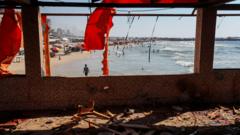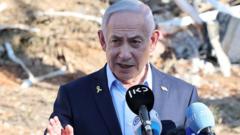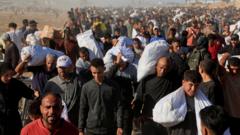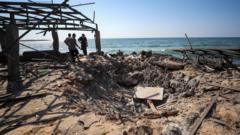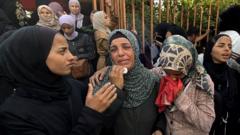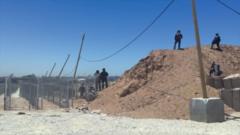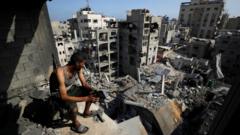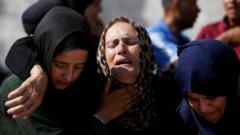### Summary: An anonymous Hamas security officer disclosed that the group's command structure has nearly disintegrated, with armed gangs now dominating Gaza. This internal power shift poses a threat to Hamas's rule as new factions emerge, backed by regional forces.
### Title: Hamas Faces Internal Collapse as Gangs Fill Power Vacuum in Gaza
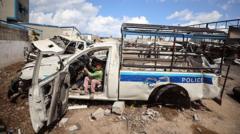
### Title: Hamas Faces Internal Collapse as Gangs Fill Power Vacuum in Gaza
### Description: A senior Hamas officer reveals that the group has lost nearly all control over Gaza, leading to chaos as local clans rise to power amid ongoing conflict.
In a striking revelation, a senior officer of Hamas's security forces has declared that the group has lost close to 80% of its control over the Gaza Strip, as local armed clans step into the power vacuum left by the ongoing conflict with Israel. The lieutenant colonel, speaking under the condition of anonymity, emphasized that the organization's command system has crumbled under relentless Israeli strikes, which have decimated its leadership.
After being injured at the onset of the war triggered by a Hamas-led attack on Israel on October 7, 2023, the officer shared voice messages detailing the internal chaos within Hamas. He noted a stark reality, stating that with approximately 95% of the leadership now dead, the group struggles to maintain any semblance of order. “What’s stopping Israel from continuing this war?” he questioned, pointing to the lack of resistance and the pervasive sense of collapse within Gazan society.
The officer described how public security has entirely failed, with no enforcement present to address rampant looting or prevent violent acts. “There's no control anywhere,” he affirmed, narrating how even Hamas's powerful security apparatus has been plundered. The chaos has allowed for criminal gangs and armed clans to flourish, often committing acts of violence with impunity.
Reports of an Israeli drone strike on June 26, which resulted in the deaths of at least 18 civilians amid a failed attempt by Hamas to regain order, further illustrate the tenuous grip the group holds on Gaza. Amidst this instability, several armed groups linked to prominent clans have emerged, notably one led by Yasser Abu Shabab—a figure who is being watched closely by both the Palestinian Authority and Israel, as the latter has reportedly begun supplying him with weapons.
Abu Shabab's rise is seen as a substantial threat to Hamas, with the officer admitting that the group fears he could unite its many adversaries. “If someone like Abu Shabab can rally those forces, that could be the beginning of the end for us,” he cautioned. The climatic conditions in Gaza demonstrate not only the direct impact of foreign military action but also the significant internal factionalism threatening Hamas's dominance.
As the conflict continues, it remains to be seen how internal strife and external threats will shape the future of governance in Gaza, with ongoing instability leading to a shift in power dynamics that could emerge from the ashes of Hamas's waning authority.
After being injured at the onset of the war triggered by a Hamas-led attack on Israel on October 7, 2023, the officer shared voice messages detailing the internal chaos within Hamas. He noted a stark reality, stating that with approximately 95% of the leadership now dead, the group struggles to maintain any semblance of order. “What’s stopping Israel from continuing this war?” he questioned, pointing to the lack of resistance and the pervasive sense of collapse within Gazan society.
The officer described how public security has entirely failed, with no enforcement present to address rampant looting or prevent violent acts. “There's no control anywhere,” he affirmed, narrating how even Hamas's powerful security apparatus has been plundered. The chaos has allowed for criminal gangs and armed clans to flourish, often committing acts of violence with impunity.
Reports of an Israeli drone strike on June 26, which resulted in the deaths of at least 18 civilians amid a failed attempt by Hamas to regain order, further illustrate the tenuous grip the group holds on Gaza. Amidst this instability, several armed groups linked to prominent clans have emerged, notably one led by Yasser Abu Shabab—a figure who is being watched closely by both the Palestinian Authority and Israel, as the latter has reportedly begun supplying him with weapons.
Abu Shabab's rise is seen as a substantial threat to Hamas, with the officer admitting that the group fears he could unite its many adversaries. “If someone like Abu Shabab can rally those forces, that could be the beginning of the end for us,” he cautioned. The climatic conditions in Gaza demonstrate not only the direct impact of foreign military action but also the significant internal factionalism threatening Hamas's dominance.
As the conflict continues, it remains to be seen how internal strife and external threats will shape the future of governance in Gaza, with ongoing instability leading to a shift in power dynamics that could emerge from the ashes of Hamas's waning authority.

